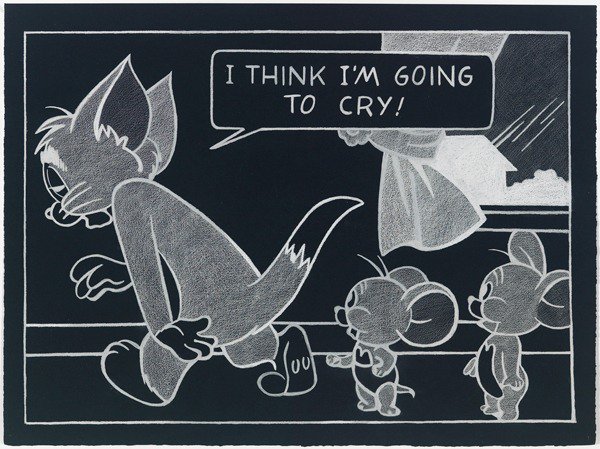Karl Haendel
dal 14/10/2010 al 12/11/2010
Segnalato da
14/10/2010
Karl Haendel
Tony Wight Gallery, Chicago
My Invisible Friend. The exhibition will feature graphite drawings, slide projections and the artist's first video in seven years. Tom is a blue and white domestic shorthair cat who usually lives a pampered life, while Jerry is a small brown house mouse who always lives in close proximity to him. The primary duties of a medieval knight; various interpretations of why Jews break the glass and others stories.

Tony Wight Gallery is pleased to present My Invisible Friend, an exhibition of new work by Karl
Haendel. The exhibition will feature graphite drawings, slide projections and the artist’s first video in
seven years.
Tom is a blue and white domestic shorthair cat who usually lives a pampered life, while
Jerry is a small brown house mouse who always lives in close proximity to him. Jerry
possesses surprising strength for his size, lifting items such as anvils with relative ease and
withstanding considerable impacts from them. Despite the typical cat-eats-mouse scenario,
it is surprisingly quite rare for Tom to actually try to consume Jerry. Regardless of his energy
and determination, Tom is no match for Jerry's brains and wits. By the final "fade-out" of
each cartoon, Jerry usually emerges triumphant, while Tom is shown as the loser. Both
characters display sadistic tendencies and take pleasure in tormenting each other. However,
depending on the cartoon, whenever one character appears to be in mortal danger, the
other will develop a conscience and save him. Multiple shorts show the two getting along
with minimal difficulty, and they are more than capable of working together when the
situation calls for it — usually against a third party who manages to torture and humiliate
them both.
Knights of the medieval era were asked to "Protect the weak, defenseless, helpless, and
fight for the general welfare of all." These were the primary duties of a medieval knight, but
they were very hard to accomplish, and rarely could even the best of knights achieve these
goals. Knights trained in hunting, fighting, and riding, as well as practicing courteous,
honorable behavior, which was considered extremely important. Chivalry was the main
principle guiding a knight’s lifestyle, and a way of demonstrating military chivalry was to own
expensive, heavy weaponry. Warriors were not only required to own all these belongings to
prove their allegiance, they were also expected to act with military courtesy as well. In
combat when nobles and knights were taken prisoner, their lives were spared and were
often held for ransom in somewhat comfortable surroundings. This same code of conduct
did not apply to non-knights (archers, peasants, foot-soldiers, etc.) who were often
slaughtered after capture, and who were viewed during battle as mere impediments to
knights fighting other knights.
At the end of the Jewish wedding ceremony the groom stomps on a glass to crush it and
the guests shout, “Mazel Tov!” There are various interpretations of why Jews do this and
where the glass breaking tradition came from. Some of the most popular explanations are:
The breaking of the glass is a reminder of the destruction of the Temple in Jerusalem. The
breaking of the glass is a reminder that even in times of great joy there is sadness, and that
life will bring both. The breaking of the glass symbolically represents the breaking of the
hymen and the consummation of the marriage. The breaking of the glass symbolizes that the
love of the couple is fragile, so it must be cared for to keep from breaking. The breaking of
the glass is a reminder that although the couple came together as a single union, the world
as a whole is broken and needs mending. The broken glass is irrevocably changed;
likewise, the couple is forever changed by marriage and must accept this and take on a new
form.
Karl Haendel earned his BA from Brown University in 1998 and his MFA at UCLA in 2003. He has
recently had solo exhibitions at The Lever House, NY; Milliken Gallery, Stockholm; Sommer
Contemporary Art, Tel Aviv; Harris Lieberman, NY; and Susanne Vielmetter Los Angeles Projects, as
well as public projects with the Art Production Fund, NY, and LAX Art, Los Angeles. His work has
been featured in a MOCA Focus solo exhibition at the Museum of Contemporary Art, Los Angeles,
CA and in the recent group exhibitions Beg Borrow and Steal at the Rubell Family Collection, Miami,
Fl; Nothingness and Being at the Fundación/Colección Jumex, Mexico; Haunted, Guggenheim
Museum, NY; Picturing the Studio, The School of the Art Institute of Chicago, Chicago, IL, and Lines,
Grids, Stains, Words: Minimal Art Drawings from the Collection of The Museum of Modern Art,
MOMA, NY. In 2011 Haendel will have solo exhibitions at Galleria Raucci/Santamaria, Naples, and
Yvon Lambert, Paris.
For information please call John Henderson at 312.492.7261, or email at john@tonywightgallery.com
A reception will be held at the gallery on Friday, 15 October, from 5–8pm.
Tony Wight Gallery
845 West Washington Boulevard Chicago IL USA 60607
Hours: Tuesday – Saturday, 11am – 5pm



